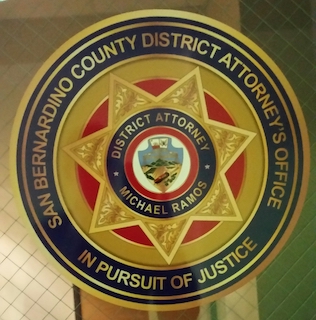At just about midnight on August 10, 1993, the San Bernardino Sheriff’s Department (SBSD) received a call that a dead body had been found at a remote residence in the Mojave Desert in San Bernardino County, California.
The victim, Pamela Richards, had been brutally beaten and suffered two fatal injuries – strangulation and blunt force trauma to her head.
 San Bernardino County DA Emblem
San Bernardino County DA Emblem
An SBSD deputy was the first to arrive at the scene, where he was met by the victim’s husband, William Richards. Mr. Richards told deputies he discovered his wife’s body lying face-down on the ground outside shortly after he returned from work. According to Mr. Richards, his wife was “stone cold” and had likely been dead for hours.
In the early morning hours of August 11, 1993, several homicide investigators arrived at the scene and eventually had the body taken back to a laboratory for an autopsy and further investigation.
Their investigation post autopsy allegedly found 15 blue cotton fibers about a half-centimeter long wedged in a crack of a broken fingernail on one of the fingers and the cotton fibers matched those of the shirt her husband was wearing the night he called the SBSD to report the dead body. The blue fibers were not noticed during the autopsy (nor by the medical examiner during finger-scraping and fingerprinting), although in the SBSD investigation, they were visible to the naked eye.
The SBSD then arrested Mr. Richards and the San Bernardino County District Attorney’s Office then prosecuted William Richards for the first degree murder of his wife.
In 1997, after four trials and two hung juries, William Richards was convicted of the first degree murder of his wife. In 2016, the California Supreme Court vacated Richards’ conviction, finding that it was based on “false evidence” as characterized in subsequently enacted legislation defining the term (Penal Code § 1473(e)(1)) and exonerated Richards of Pamela’s murder.
The false evidence was the “planted” blue shirt fibers and a declaration from an expert witness, who during the fourth trial (wherein Richards was convicted) had testified that certain bitemark evidence on Pamela’s body matched the teeth of her husband. The county’s odontologist expert who testified at trial recanting his earlier opinion that the bitemark evidence showed bites from William Richards.
Mr. Richards then brought a 42 U.S.C. § 1983 civil action against the SBSD, the San Bernardino County District Attorney’s Office and various individuals (collectively, “Defendants”), alleging that Defendants presented deliberately false evidence in violation of his civil rights during the 1993 murder investigation and prosecution, resulting in a deliberately erroneous conviction.
The U.S. District Court granted summary judgement for defendants, finding that Richards did not “carry his burden to show that the investigating officers committed any [federal] constitutional errors in their investigation of Pamela’s murder.” The District Court found that the bite mark evidence, not the blue shirt fiber evidence, was necessary to convict Richards and the expert opinion was not deliberately false. It was just erroneous and sloppily evaluated.
Richards appealed this ruling to the United States Court of Appeals for the Ninth Circuit in Pasadena.
The Ninth Circuit reversed the summary judgement in favor of Defendants and remanded the case to the district court.
The Ninth Circuit acknowledged that the traditional means of proving factual causation is showing that “but for the defendant’s unlawful conduct, [his or her] alleged injury would not have occurred.” Comcast Corp. v. Nat’l Ass’n of Afr. Am.-Owned Media (2020) 140 S. Ct. 1009, 1014.
However, the Ninth Circuit held, a less demanding causal standard is necessary when constitutional rights are implicated. In the context of evidence suppression, causation may be shown if there was a reasonable probability that the result of the proceeding would have been different if the evidence had been disclosed. Kyles v. Whitley (1995) 514 U.S. 419, 433 (quoting United States v. Bagley (1985) 473 U.S. 667, 682).
Here, the issue was simply the right to a fair trial, a fundamental due process issue. The same rationale motivating a lesser standard in suppression would apply to deliberate fabrication of evidence cases because the accused’s right to a fair trial applies whether he is innocent or guilty.
On remand, the district court will have to find whether there was a reasonable probability that the verdict would have been different if the blue shirt fiber evidence and the false expert witness testimony were excluded.
We present this article because it is not uncommon for family and friends to call us about false evidence being used to convict a person, however, this case shows that there are several important steps in getting to a civil case against law enforcement and the prosecuting agency and that critical first step is a judicial finding (here, the California Supreme Court) that the conviction was based on “false evidence.” That is the hard part that most people overlook and instead want to simply proceed with a civil case, which is a mistake.
The citation for the United States Court of Appeals, Ninth Circuit, ruling discussed above is William Richards v. San Bernardino County District Attorney’s Office (9th.Cir. 2022) is ordered not to be published and is no to be regarded as precedent except as provided by Ninth Circuit Rule 36-3.
For more information about civil cases arising from criminal matters, please click on the following articles:
 San Bernardino County DA Emblem
San Bernardino County DA Emblem